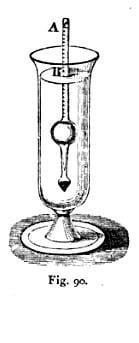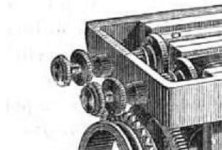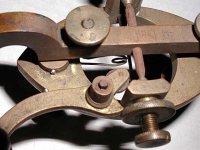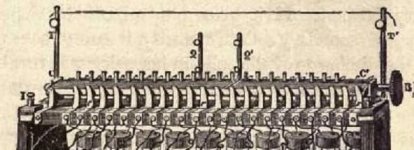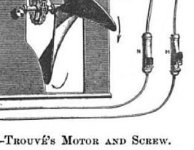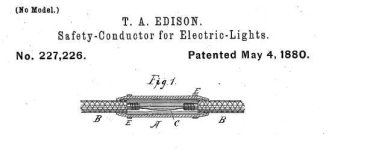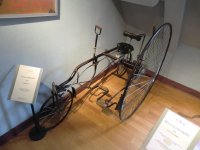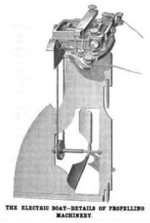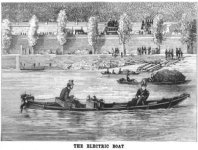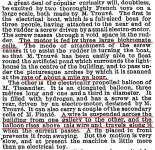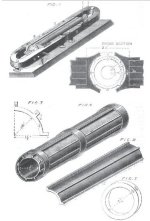ELECTRIC MOTORS. Upon the discovery of electricity, as it were, we thought to use the magnetic repulsion and attraction as a motor, but after the discovery of electro-magnetism only, those desires could not be regarded as absolutely chimerical; we therefore wanted to replace the steam by electricity and that it could make machines move, dragging a burden, do all sorts of sensitive or difficult works. To date, the efforts of inventors have been almost fruitless. "There's no stopping, said M.de Parkville in 1878, to electric motors. The few types seen at the Exhibition can no longer mislead anyone. Electricity is too expensive. By turning a simple crank almost effortlessly, it does produce the magneto-electric machines a quantity of electricity equivalent to that of a Bunsen battery of 10 elements, so with very little strength, it develops a lot of electricity. The converse is true, with a lot of electricity, it produces very little strength. This can be translated into a single number: the most economical battery needed to produce electricity only works in oxidizing zinc. An electric motor consumers zinc and a steam engine consumes coal. Precious zinc costs fifteen times more than oil, and oxidation of zinc does that 5,000 calories, when the oxidation of coal produced in 8000. An electric motor spends very near thirty times more than a steam engine. Electric motors can therefore be of interest only when the industrial physicists have found a way to produce cheap electricity."
But the day you happen to produce a motor, the industry would make such progress it is important not to despair. That day, in fact, we see the workers working in room, working as a sewing machine so tired now, the owner in search of well-being, employing only a few small industrial tools and which the steam is too embarrassing. etc., use of this new force, which will result in a complete transformation both in industry and in our private lives and in our social and moral life.
In 1835, at the time of the invention of constant piles, Jacoby executed on the Neva, the first experiments with an electric motor. He applied it to navigation. His boat, large enough to contain a motor pile, was equipped with paddle wheels. It seems that the motor unit consisted of two large discs, each garnished with four electro-magnets perpendicular to its plane, and one of which was fixed and the other movable about a horizontal axis. Was obtained by continuous rotation of alternative attraction and repulsion, which occurs when the moving electro-magnets pass the fixed electro-magnets. It was served by a pile of 128 pairs of Grove cells, where the platinum surface was 3 to 4 square meters, of which the current was strong enough to blush a wire 0m,001 in diameter and 2 meters in length. The experience cost 60,000 francs paid by the Emperor Nicolas, and could not be repeated.
In 1866, the Comte de Mollins repeated Jacoby's experience on Lake of the Chalet du Bois de Boulogne, with an iron boat with flat bottom. The machine was powered by twenty Bunsen cells. It consisted of a motor rotating a horizontal shaft, which connected the movement with two propellers placed, one right and one on the left, using a Vaucanson chain. This boat, as well as Mr.Jacoby, had twelve people. The result of this experiment were interrupted by the death of the inventor.

Since, a large number of electro-motor machines have been built among which we mention those of MM.Ritchie, Larmengeat, Froment, Bourbouze, Kravogl, etc.. As they are all based on the same principle, we will only describe that of Mr.Fromont, one of the best. It consists (fig.136) in four electromagnets arranged on a frame of cast iron. A wheel, with eight plates of soft iron, can move between the electro-magnets, they do not act together, but successively. Frames, attracted by the electricity rush in their direction and speed gained by exceeding the electromagnets also cease to function when the plates pass before them, a switch is arranged for that. It is an extension of the axis of rotation that is seen in front of the figure, and three rollers attached to the end of spring steel; bulges that exist on the axis alternately lift each wheel, influence the corresponding spring and make a contact, so that way the electromagnet receives the corresponding current.
In 1880, M.Trouvé devised a new motor, based on improvements he brought to the Siemens bobbin, and has made quite a noise. The device consists (fig.137) of a Siemens bobbin, which is rotated using a switch between the poles of an electromagnet. Here is how the author expresses himself on the changes he has done to the Siemens bobbin:
View attachment 1
Fig. 137. Trouvé Motor.
AA. Poles of the electromagnet fixed. B. Iron bobbin.
C. Bobbin of the electromagnet A. IJ. Axis of the bobbin.
FH. Poles of the motor pile. D. Copper frame.
E. Cast iron frame.
"When we trace the dynamic diagram of a Siemens bobbin by making a complete revolution between two magnetic poles which react on it, we see that the work is almost nil for two periods of rotation. These two periods correspond to times during which the poles of the moving bobine, having reached the pole of the fixed magnet parade before them. During these two fractions of the revolution, which are each about 30°, the magnetic surfaces, intended to react one upon the other, are equidistant from the iron of the bobbin, which is not sought to turn. This results in a significant loss of work. I deleted those periods of indifference and increased the effectiveness of the machine, by altering the bobbin: the pole faces, instead of portions of a cylinder whose axis coincides with the system, are like snail shells, so in turn they gradually approach the surface of the magnet, until the trailing edge drops the pole of the magnet. Repulsion begins by following the reverse flow, so that the neutral point is virtually avoided."
M.Trouvé has devised several ways to obtain this result, either offset the cheeks of the bobbin, or rather eccentric exciter, the cheeks of the bobbin remaining concentric. Designs 2 and 3 in the figure give, in horizontal and vertical section, the two main forms that have been most successful: figure 2 shows a helical bobbin carrying two pallets; figure 3 shows an elliptical bobbin.
The electric motor is certainly able to operate a sewing machine, but as for other engines, the maintenance cost of a battery makes it impossible. It may be suitable not only for luxury applications, such as the functioning of small milling machines and dentists and watchmakers lathes, the ventilation of apartments, amateur lathes, etc.. Physics teachers will use it to conduct experiments that require little mechanical force, such as the start of static machines, etc. At the Electrical Exhibition of 1881, it operated the small balloon presented by Mr.Tissandier. It has mainly been observed in experiments on locomotion of practical vehicles and light boats.
On a tricycle of English construction, very heavy (55 Ibs.) M.Trouvé had one of his motors below the axle of the wheel which communicated the movement through a Vaucanson chain. The motor was powered by six secondary cells or accumulators of the Plante type, he built with such perfection. The total weight of the vehicle, batteries, engine and rider included, up to 160 kilogr., and the effective force of the motor 7 kilogrammetres. Nevertheless, the tricycle has set itself in motion, once we had established electrical communication and traveled several times in both directions, the Rue de Valois, the speed of a good car. The experiment lasted one hour and a half (fig.138) and is conclusive.
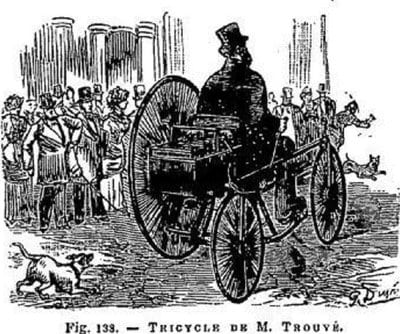
The second application of M.Trouvé is no less happy than the first, we want to talk about his electric boat with which he went up very easily during the course of the Seine in Paris, with three people in his boat. The experiments were conducted on the Seine, the Pont-Royal, 26,27,28 May and 3 June 1881, in the presence of the highest scientific and political notables, left nothing to be desired (fig. on page 361). Each trip was to go up the Seine from the dock and return, located just below the Pont-Royal to the Pont des Arts, then dropped back to starting point. The time for each trip turned out exactly the same from first to last, which shows sufficient consistency of the pile and safety of the Trouvé motor, each experiment included a couple of trips that lasted between one hour and a half and two hours. The engine was powered by two bichromate of potassium batteries of six cells each. The velocities obtained per second, measured precisely by means of a log, were 1m,50 or 4,500 meters per hour, with a propeller with three branches, up the stream of the Seine, and 2m,50 or 8,640 meters per hour, down river. This new application of electricity, made entirely practical, is very studied, the more one examines the details, the more we realize that nothing has been left to chance, since the rudder, engine, propeller, to the disposition of the batteries, everything points to a great accomplishment.


